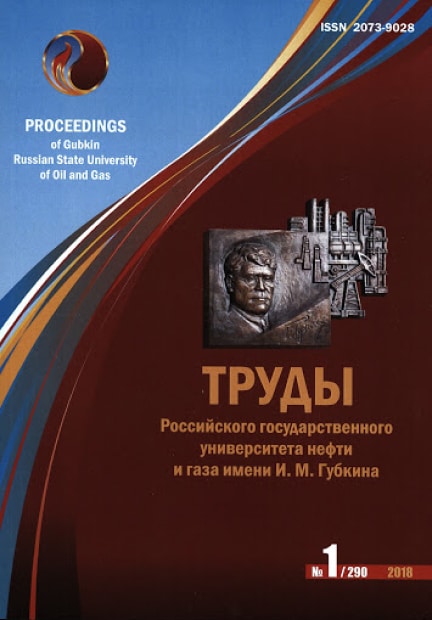Scientific and technical journal
«Proceedings of Gubkin University»
ISSN 2073-9028

Analysis of current concepts of cavitation bubble collapse process in terms of applicability to design of jet equipment for oil and gas technologies
UDC: 620.193.16
DOI: -
Authors:
1 Kuban State Technological University, Krasnodar, Russian Federation
Keywords: jet system, cavitation, bubble collapse, surface tension, energy dissipation rate, microjet, collapse, water hammer
Annotation:
Theoretical and experimental studies of cavitation phenomena have a long and extensive history and are associated with the names of such outstanding scientists as O. Reynolds, Lord Rayleigh, M. Plesset, and Academician E.I. Zababakhin. However, the achievements in this branch of science have so far been applied inconsistently to jet systems for drilling and cementing fluids. Authors generally limit themselves to speculations about the extraordinarily high pressure spikes during cavitation bubble collapse and, consequently, the great potential of cavitation for grinding suspended particles in the preparation of drilling and cementing fluids as well as for cleaning wellbores from clogging substances. Nonetheless, significant effects on an industrial scale have not yet been achieved. In order to develop scientifically grounded recommendations for the design of these processes, an analysis of existing data in the scientific and technical literature is performed. This analysis is specific to the cavitation bubble collapse process, focusing on the application of the released energy to impact the components of drilling and cementing fluids during their preparation and processing.
Bibliography:
1. Pahlyan I.A. Osnovy proektirovaniya strujnyh apparatov dlya neftyanoj i gazovoj promyshlennosti // Neftepromyslovoe delo. – 2012. – № 12. – S. 15–17.2. Omel’yanyuk M.V., Pahlyan I.A. Issledovaniya generatorov kavitacii dlya processov vibrovolnovoj raskol’matacii dobyvayushchih skvazhin // Oborudovanie i tekhnologii dlya neftegazovogo kompleksa. – 2022. – № 5. – S. 15–19.
3. Lord Rayleigh. On the pressure developed in a liquid during the collapse of a spherical cavity // Philos. Mag. – 1917. – Vol. 34, № 6. – Р. 94–96.
4. Zababahin E.I. Nekotorye sluchai dvizheniya vyazkoj zhidkosti // V kn.: Voprosy sovremennoj eksperimental’noj i teoreticheskoj fiziki. Sbornik nauchyh trudov. – L.: Nauka, 1984. – S. 58–68.
5. Landau L.D., Lifshic E.M. Teoreticheskaya fizika: T. VI. Gidrodinamika. – 5-e izd. – M.: Fizmatlit, 2001. – 736 s.
6. Mancuso G., Langone M., Andreottola G. A critical review of the current technologies in wastewater treatment plants by using hydrodynamic cavitation process: principles and applications // Journal of Environmental Health Science and Engineering. – 2020. – Vol. 18. – P. 311–333.
7. Lauterborn W. Ohl C.-D. The Peculiar Dynamics of Cavitation Bubbles // Applied Scientific Research. – 1998. – Vol. 58. – P. 63–76.
8. Kornfeld M., Suvorov L. On the Destructive Action of Cavitation // Journal of Applied Physics. – 1944. – Vol. 15, June. – P. 495–506.
9. Plesset M.S., Chapman R.B. Collapse of an initially spherical vapour cavity in theneigh-bourhood of a solid boundary // J. Fluid Mech. – 1971. – Vol. 47, part 2. – P. 283–290.
10. Sankin G.N., Yuan F., Zhong P. Pulsating Tandem Microbubble for Localized and Directional Single Cell Membrane Poration // Physical Review Letter. – 2010. – August 13, vol. 105.
11. Jing Luo, Zhipan Niu. Jet and Shock Wave from Collapse of Two Cavitation Bubbles // Nature: Scientific Reports. – 2019. – 4 Feb, vol. 9, article index 1352.
12. Dynamics of laser-induced bubble pairs / B. Han, K. Kohler, K.Jungnickel [et al.] // J. Fluid Mech. – 2015. – Vol. 771. – P. 706–742.
13. Hyo Na Kim, Suslick K.S. Sonofragmentation of Organic Molecular Crystals vs Strenght of Materials // The Journal of Organic Chemistry. – 2021. – March 15, articles ASAP. – 7 p.
14. Visualisation of acoustic cavitation effects on suspended calcite cristals / R.M. Wagterveld, L. Boels, M.J. Mayer, G.J. Witkamp // Ultrasonics Sonochemistry. – 2011. – Vol. 18. – P. 216–225.
15. Experimental investigations of interactions between a laser-induced cavitation bubble and a spherical particle / Yuning Zhang [at al.] // Experimental Thermal and Fluid Science. – 2018. – Vol. 98. – P. 645–661.
16. Linzheng Ye, Xijing Zhu. Analysis of the effect of impact of near-wall acoustic bubble collapse microjet on Al // Ultrasonics Sonochemistry. – 2017. – Vol. 36. – P. 507–516.
17. Liang Lu, Yongxue Zhang, Yuning Zhang. Experimental investigations of the particle motions induced by a lasergenerated cavitation bubble // Ultrasonics Sonochemistry. – 2019. – Vol. 56. – P. 63–76.
18. Peters A., Lantermann U., Moctar O. Numerical Modelling and Prediction of Erosion Induced by Hydrodynamic Cavitation // Journal of Physics: Conference Series. 9th International Symposium on Cavitation. – 2015. – 4 p.
19. Delmas H., Barthe L. Ultrasonic mixing, homogenization, and emulsification in food processing and other applications. Power Ultrasonics: Applications of High-Intensity Ultrasound // Elsevier. – 2015. – P. 757–791.
20. Vliyanie konstruktivnyh osobennostej rotorno-diskovyh smesitelej na dispersnyj sostav emul’sij / S.V. Laponov, N.S. Shulaev, S.P. Ivanov, I.G. Ibragimov // Trudy Rossijskogo gosudarstvennogo universiteta nefti i gaza imeni I.M. Gubkina. – 2018. – № 1.